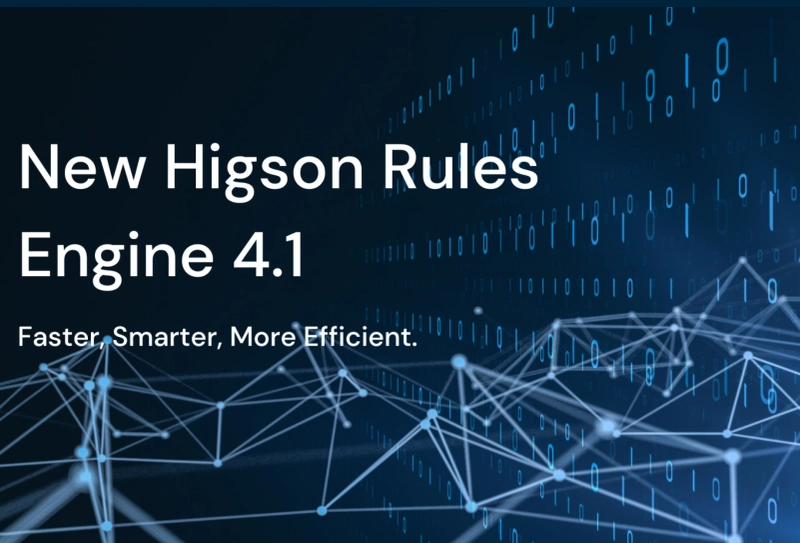Performance: Measurable, Not Assumed
In large-scale environments, the performance of a rules engine isn’t a theoretical concern it determines whether rule-driven logic can be used in core systems or must remain on the margins. Higson 4.1 business rules engine introduces major improvements to rule evaluation time and memory usage, making it viable not just for batch operations but for systems under continuous load.
Optimizations in table indexing and rule lookup have reduced memory consumption by up to 46%, with lookup times improved by a factor of up to 22. This means that even rule sets with hundreds of thousands of rows, common in pricing, claims, and product configuration scenarios can now be evaluated with negligible latency. Combined with enhanced execution of chained logic, these improvements make it possible to embed business logic in customer-facing applications without compromising performance or scalability.
Integrated Testing and Deployment Transparency
As decision automation becomes more central to business operations, testability and change management are no longer optional. Higson’s latest release introduces a more accessible, structured approach to rule testing. With built-in test case support and visual result feedback, business teams can validate rule behavior without relying on developers or custom scripts.
Test outputs are versioned, exportable, and easily linked to rule changes - a crucial feature for regulated industries where auditability is a non-negotiable requirement. This shift toward “transparent rule governance” allows organizations to move faster while maintaining control and accountability.
Function Reusability and Authoring Simplicity
A common challenge in rule authoring is balancing reusability with clarity. Higson 4.1 addresses this by refining its support for shared functions small, reusable blocks of logic written in Groovy that can be embedded in rules across domains. These functions now execute with lower latency, and improvements to their management interface make it easier for analysts to track dependencies and maintain consistency.
The rule editor itself has also been enhanced to offer contextual suggestions, built-in utility functions (for strings, dates, numbers), and syntax validation, further reducing the entry barrier for non-technical users.
Operational Flexibility Through Integration
Beyond performance and authoring, Higson 4.1 continues to support modern integration patterns required in distributed architectures. Whether deployed as a standalone service with a RESTful API or embedded within microservice ecosystems via Spring Boot, the engine adapts to varying infrastructure needs. Backward compatibility is preserved, ensuring that upgrades do not disrupt existing deployments a practical but often overlooked benefit.
These technical foundations are particularly relevant for insurers seeking to modernize their platforms without undergoing a full system replacement. Higson can be introduced incrementally, powering discrete decision points, such as claims triage, policy validation, or product recommendation — and scaled as trust in rule automation grows.
Certified Security for Enterprise-Grade Confidence
In addition to performance and usability improvements, Higson 4.1 introduces a notable advancement on the security front. The platform has recently received a Certificate of Trust, confirming its compliance with key security and data protection standards. This certification reflects the growing need for assurance in enterprise environments, particularly in highly regulated sectors such as insurance and finance.
Real-World Implications in the Insurance Sector
While improvements in execution speed and usability are valuable on their own, their impact is best understood in context. One European insurance provider using Higson to manage underwriting and renewal decisions reported reducing their processing latency by over 60% after upgrading to version 4.1. More importantly, they were able to expand the scope of automated decision-making to include mid-term policy adjustments something previously avoided due to performance limitations.
In another case, a health insurer applied Higson’s rule chaining and test automation features to improve fraud detection in duplicate claims processing. By embedding rule logic into pre-authorization checks, the team could flag suspicious claims before they entered the main review queue, significantly reducing workload and response time.
These examples illustrate how performance is not an isolated concern, but a foundational enabler of broader automation goals.
Conclusion: Toward Embedded, Real-Time Decisioning
As decision logic becomes more distributed and interwoven into real-time customer journeys, the expectations placed on rule engines are rising. They must execute fast, scale easily, support self-service by business users, and remain auditable. Higson 4.1 is an example of how this can be achieved not through superficial interface changes, but by addressing the technical realities of execution, testability, and integration.
If you want to try - check out Higson 4.1 demo.


